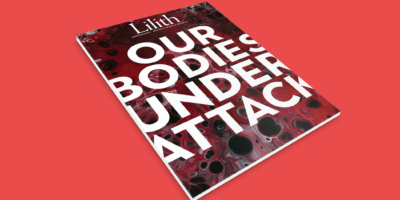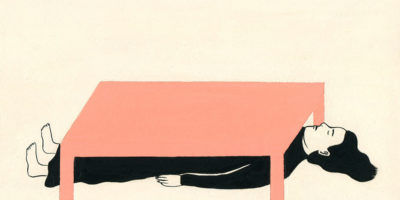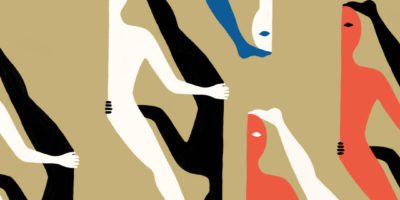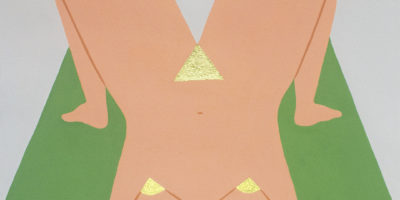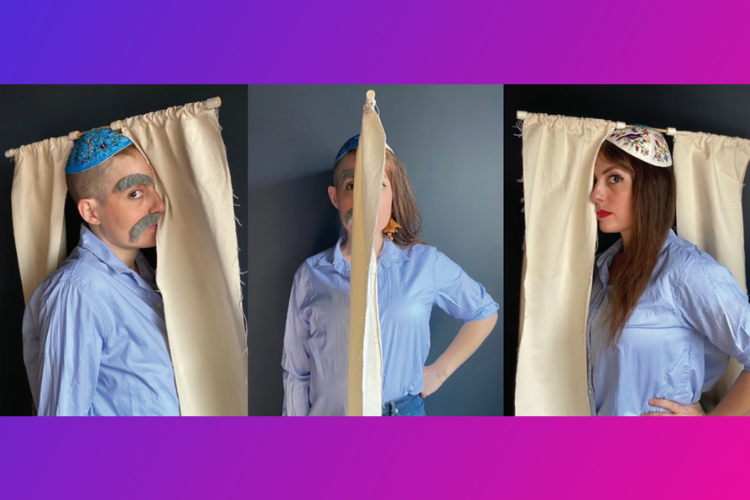
I Dressed as a Mechitza… for Feminism
Mechitza: (partition or division; plural: mechitzot) in Judaism, is a partition, particularly one that is used to separate men and women in Orthodox religious services
T, my dear friend of twenty years, knows my negative feelings about mechitzas. So, before Purim, she called to warn me that her daughter’s forthcoming Bat Mitzvah megillah reading would occur at an Orthodox shul with such a structure in place. This put me in a bind. I’ve known this young lady since her first week on earth, and I could not imagine missing her big night. But as a rule, I do not attend segregated services.
So T and I came up with a compromise. I would show up to her daughter’s Purim reading, in costume, dressed as a mechitza, and stand on the men’s side of the divider.
As a visual artist, I loved the challenge of crafting a visible device to separate myself into male and female halves, and landed on creating a curtain-like structure attached to the top of a yarmulke, the long fabric dividing my body in half. On one side of the curtain I would appear as a woman, with long hair and bright lipstick, while on the other side my bald head, fake gut, and artificial mustache would read as male.
I make politically progressive, passionately Jewish art that lots of Jews don’t like. Mostly, my work critically examines the political and psychological complexities of American Jewish wealth, the experience I come from. It won’t surprise you that I’ve grown accustomed, over the years, to negative feedback from my own people. However, before creating “Mechitza,” my Jewish output has exclusively been video art and sculpture. Walking toward the shul door the night of Purim, awkwardly navigating the fabric dividing my body and the partial vision created in its wake, I was nervous. This wasn’t a screening or exhibition opening. This was me, in the flesh, visually enacting on my person my feminist critique of mechitza, in a physical space containing one.
Let me be clear; we’re talking about a super-modern Orthodox congregation, in Brooklyn. The kind of site containing both a mechitza and the rabbi’s announcement, at the start of services, for any trans people to pick their preferred side of the shul. I did not perform this art protest in a rigidly conservative space, because I do not, as a rule, enjoy verbal and physical violence against my person.
With a mix of dread and adrenaline, I entered the cavernous hall, and positioned myself directly behind the mechitza already in place, a purple fabric curtain about four feet high in the middle of the floor. Immediately, a woman donning a bright magenta wig and a warm, big smile approached me. “I love your costume!” she said. “What inspired this?”
I explained my stance on mechitzas, the agreed compromise with T, and ended by asking her, “Can you believe we’re still doing this to women? In 2022? It’s shameful!” She did not respond, but quickly backed away from me, silently, her large grin seemingly stuck on her face in anxious retreat.
My showing up as a mechitza invited folks around me to talk, sometimes intimately, about their history with and relationship to these dividers. Some women explained the relief and joy of not being expected, in this one aspect of their lives, to sit beside their husbands. Other congregants extolled the benefits of their daughters being surrounded by Jewish women of all ages. Not compelling arguments to me personally, but certainly a different take.
One man, a self-described wrestler with Orthodoxy, confessed that he too had come only to support T’s daughter, and thanked me for my costume, filming and photographing me extensively, mostly staying by my side. I will always be grateful for his support and presence that evening. Child after child inquired about my getup, most unable to guess its meaning, even when I pointed to the nearby mechitza as a clue. That response struck me—how quickly we integrate bigoted ritual norms and then render them assumed, unspoken, almost invisible. Just visually highlighting the choice to segregate by gender proved a small form of resistance.
Following Purim, I felt my usual feminist Jewish rage, but also a new, joyful permission. Do I wish mechitzas would disappear from ritual life immediately? You bet. But just the act of forcing dialogue about them with other Jews, through my work, left me feeling giddy and strong.
From the Lilith Blog, June 2022. Read the full article here.

